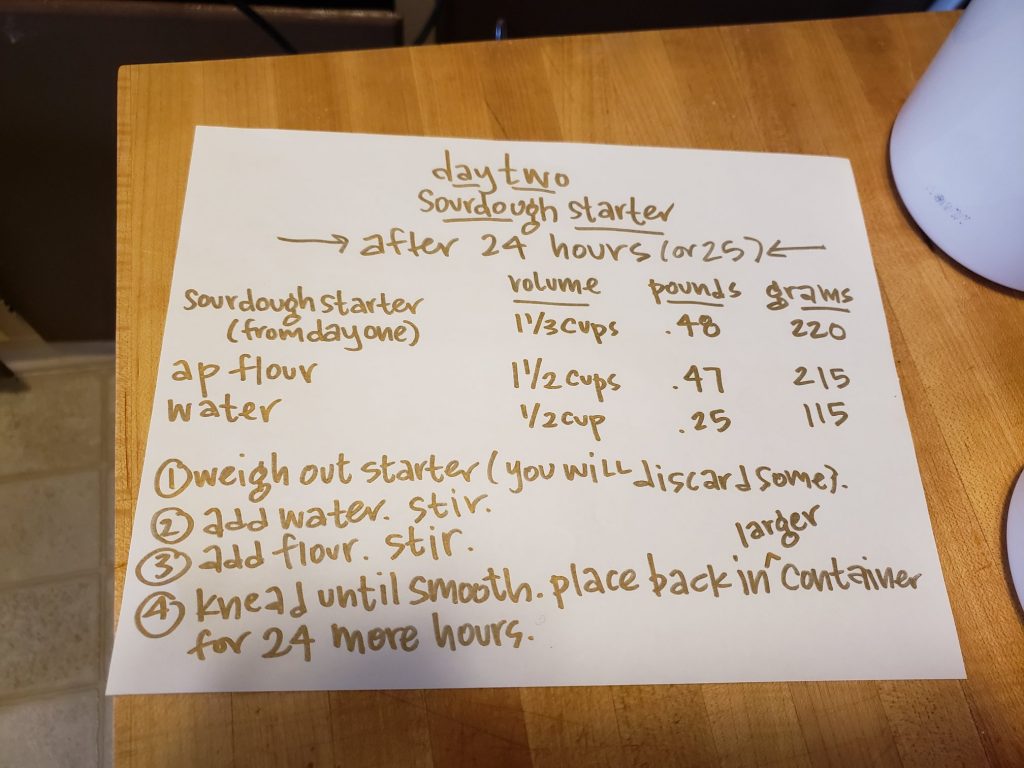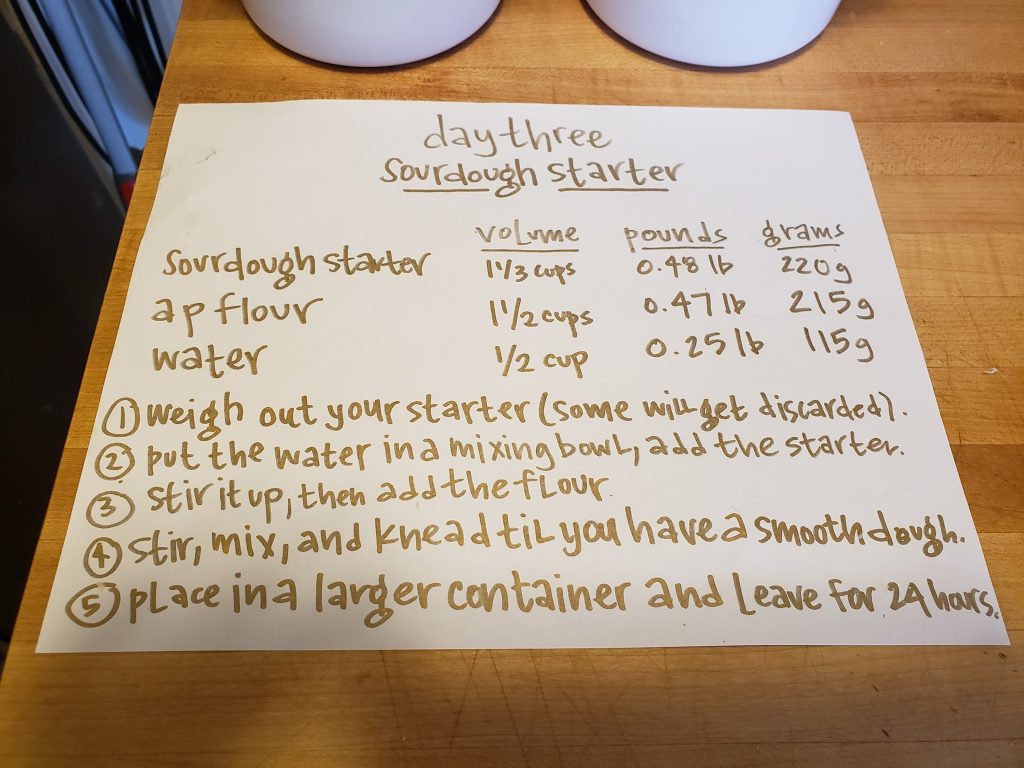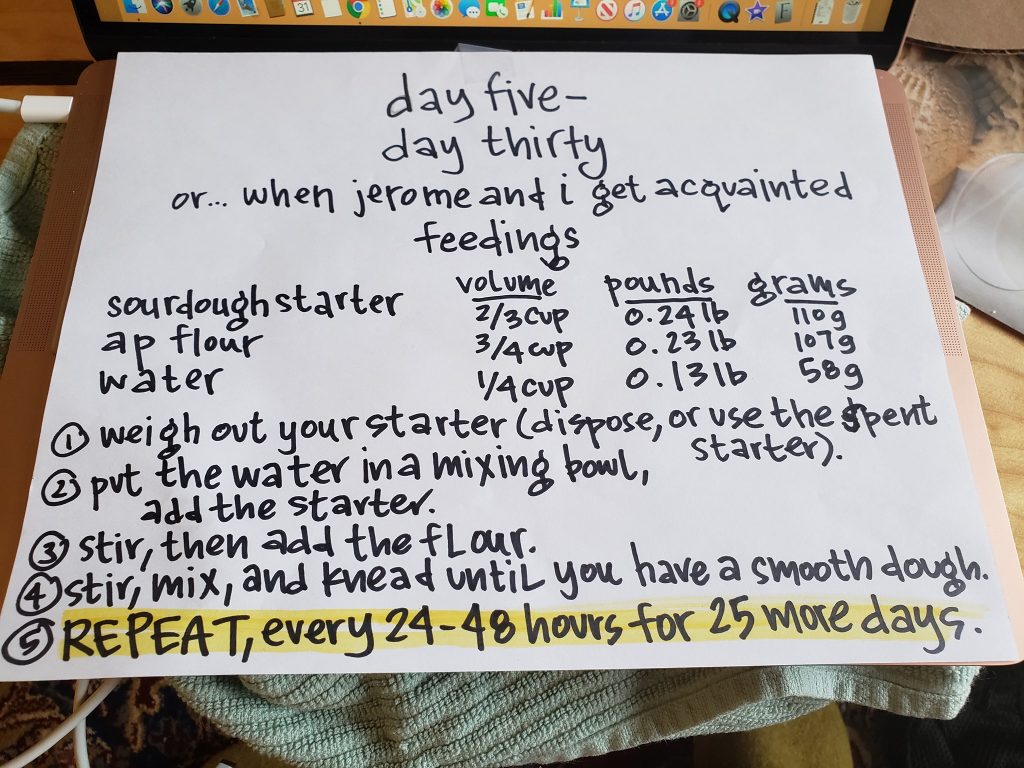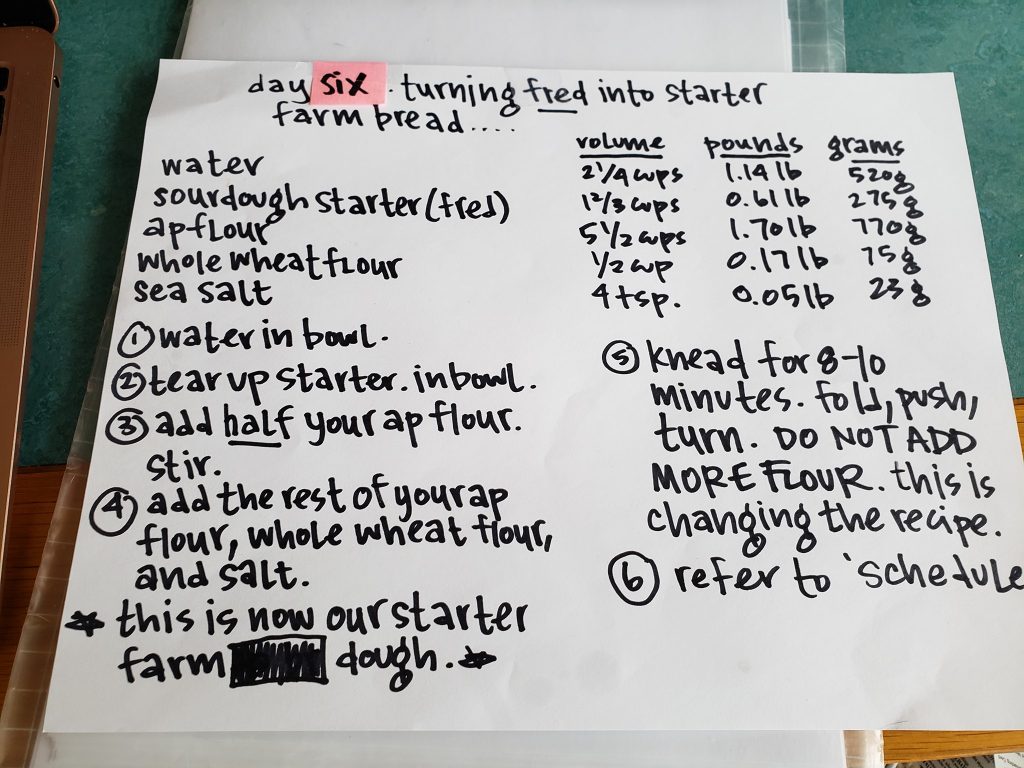Growing up, my family kept not a sourdough starter, but a loaf of bread in the refrigerator. Sometimes it would be there for days, sometimes a week or two. It was essentially a white sandwich loaf with enough whole wheat and oats that it could masquerade as something healthy and whole wheat. The bread wasn’t exceptional but it did the job. It never went bad and is still a loaf you can buy at the grocery store.
In culinary school, we spent 12 weeks on breads over the course of 2 years—I am embarrassed to say that my retention was little. I do remember that the levain that was kept on in the bread classroom was over 50 years old (though I am sure that some hapless culinary student in their early days of learning tossed it into the compost bin). I came out of those classes with dozens of recipes that I never used again.
Upon graduation, I worked in different bread bakeries and remained somewhat clueless and intimidated. It all seemed like magic to me. How did anyone know when the bread was ready to be baked? How did the bucket of flour and water that was fed so lovingly every 12 hours, with no days off for holidays, make that delicious loaf of polenta sourdough that I was madly in love with?
I can say with certainty that the majority of what I know about making naturally leavened breads came with a lot of trial and error in my home kitchen with my first sourdough starter. Before I came to BAKE!, I was in graduate school and had a dining room table that could seat 15 people. Every Saturday morning, I would wake up at 6 am to make sure that the bread was going to be out of the oven by 6 pm for the dozen or so classmates who would come for dinner, but really just wanted loaves and loaves of bread. I loved that starter. We got to know each other well. I didn’t yet know about the importance of naming starters, and sadly, it did not survive the move to Michigan.
What I now know, 20 years on, is that there is still some magic in naturally leavened breads, but it’s more patience and paying attention. You don’t need the water of San Francisco or flour made by monks in Texas to make amazing bread at home. But you need to fail a few times, and you need to know that there is a level of commitment, albeit small, and that it can be a part of your day and your life.
With that in mind, here’s my day-by-day guide to starting your own sourdough starter.
1st Day

2nd Day
Visit our YouTube playlist for videos for Day 2 and beyond!

3rd Day

4th Day

5th Day

We’re going to keep baking with Jerome; follow along on the Zingerman’s Bakehouse Facebook page as I still have some more bread to bake…..
Sourdough Starter FAQs
1. What tools do I need to get started on my sourdough journey?
- Good, wide-mouthed bowl (12 quart is a good size)
- Plastic card
- Bench knife
- Small container with lid (for starter)
- Larger container with lid (for dough)
- Wooden spoon
- Lame
- Bread Baskets
- Patience, patience, and more patience
2. Do I have to have whole wheat flour to begin my starter?
The bran and the germ on the outside of the wheat berry contain critical nutrients and enzymatic goodness to get your starter going. All-purpose flour contains only the endosperm of the wheat berry and it is more difficult to get your starter going.
That said, if you have any sort of whole grain (spelt, kamut, rye) that should get your starter going nicely.
3. What should I name my starter?
Anything you want, as long as you keep it alive. Some previous starter names that stand out include: Bread Pitt, Fred, Albus, etc…
4. What do I do with my sourdough discard?
Please check out our BAKE! Facebook group (or email [email protected] if you aren’t a member already so we can add you) for great ideas as to what to use your discard for.
5. Why are there so many ways to get sourdough starters going?
Many bakeries and bakers have sourdough methods that work for them. There are many types of starters (firm and liquid) out there in the world but the idea behind them is the same: capture the wild yeast that is all around us in the world and use that to leaven your bread and add flavor.
6. Do I have to throw my starter away? Why? Why?
Please listen to this lovely video from Vanessa Kimball, a baking instructor who is well versed in all types of sourdoughs and does a magnificent job of explaining what’s going on inside your starter.
7. Do I have to feed it every day?
You do…but only in the beginning! Once you get in a good relationship with your starter (you know how often it needs to be fed, it knows when you will feed it), you will be able to refrigerate your starter for days at a time and then bring it out for feedings. This will probably take 2 weeks.
8. What is this Put Away Farm and/or Levain stuff? Do I need to have all that AND a starter?
A very fine question.
Put Away Farm is a piece of farm bread dough that has been cut off before the loaf is proofing, put in the fridge, and used within 5 days. After 5 days, you pull it from the fridge, feed it, let it sit for 6-8 hours and at that point it becomes levain. If you are not baking with it it goes back in the fridge and it turns back into Put Away Farm.
Levain is Put Away Farm that has been fed, left to ferment on the counter for 6-8 hours, and then used in any naturally leavened bread recipes that calls for levain (this recipe is on page 42 of the cookbook).
Once you have your Put Away Farm, as long as you feed that and keep it alive, there is no need to maintain a starter as well.
9. Some of your breads use Put Away Farm and some use Levain. How come?
They are the same guy, the same little organism, doing ultimately the same good work, they are just at different stages of their flavor development and leavening power.
If you take the Put Away Farm from the fridge and do not feed it, and attempt to use it in place of the Levain, you are going to get very flat loaves.
10. It seems like bread recipes I read assume a more wet/hydrated sourdough starter made with a higher ratio of water. How will we use this firm starter in a recipe like that?
Right now, with the Zingerman’s way, we are making a firm starter that is 54% hydration. How did I get that number?
Recipe:
107 grams of starter
110 grams of all-purpose flour
58 grams of water
Water/AP Flour (58g/107g)= 54% hydration
If I want a more liquid starter, I can just start feeding the starter more water. For example, if I want 70% hydration:
Recipe:
107 grams of starter
110 grams of all-purpose flour
77 grams of water
Water/AP Flour (77g/110g)=70% hydration
And so on. Every recipe is a little different; it all depends on what they ask you for BUT once you have a robust starter going it’s easy enough, with about 3 feedings, to transition one starter to the other.
BAKE! Principal and Instructor
At the age of 4, Sara climbed on the kitchen counter to 'taste' vanilla extract. Disappointed by the taste (how could something that smelled so good taste so bad?), she was caught by her mother and had to sheepishly explain what she was up to. Fast forward ten years and Sara was selling homemade sandwiches and cookies to her friends at lunch and still running lemonade stands with her best friend. This love of all things food, and especially baking, led Sara to the Culinary Institute of America where she got her degree in baking and pastry arts. She baked and cooked her way across the country, working everywhere from NYC to San Francisco, Atlanta, Alaska, North Dakota, and even Cambridge, England.
Sara received her master's degree in hospitality management from Cornell University, where she helped teach and develop curriculum for an undergraduate restaurant course. After years of wondering how Zingerman's made their deliciously perfect Cosmic Cakes, she is thrilled to be a part of the team and learn the secrets to pass on to BAKE! students.



Do you make the Levain at night before you go to bed? If it do it in the morning, the Levain would not be ready until mid afternoon, and if i want to make Farm Bread – that takes another 8 hours.
Hi Michele! Yes. This is exactly what I do. Make the levain before I go to bed, wake up in the morning, and then get the process of making Farm Bread going. A few extra hours on your levain (10 instead of 8), is just fine.
Thanks Sara – if i make the Levain earlier in the day and run out of time – can i just put the whole thing in fridge and take out to room temp the next day? or do i start over?
You got it! I wouldn’t let it sit any longer than 12 hours in the fridge before you use it; after about 12 hours it cycles back to Put Away Farm.
Sara – this was helpful. I was confused at what to do after I made the levain and used it for another bread – like the Roadhouse Bread.
First try at farm bread went pretty well. Now I have Put Away Farm but no starter. Can I use PAF to make other kinds of sourdough besides farm bread? What if a recipe calls for starter?
Hi Jim! You can transition your PAF to a different type of starter (with 3-4 feedings based on what that particular recipe calls for). You can also revert your PAF back to starter by feeding it with the starter recipe (again, 3-4 times). Once you have captured that wild yeast it is easy to move back and forth between different recipes as long as you are feeding regularly.
Is the recipe to make bread again the same at day 6 even though I have Levian now and not starter?
Yes Faye! Sorry for the overdue response. You got it.
What size Dutch Oven do you bake the bread in?
Hi Kendra! I use a 5 quart Dutch oven; that has worked really well for me.
Do you feed put away farm using the same recipe from day 5 when you fed the original starter?
Hi Heather, Sara says: “I feed every 5 days: 115 grams water, 115 grams Put Away Farm, 230 grams AP Flour. Mix, let sit for 6-8 hours (at this point it is now levain). If you are not using, put back in fridge (at which point it is Put Away Farm for the next 5 days) until you need to feed again.”
Hi! I am concerned about my starter. I have been following along with the instructions and videos (thank you for all of that!) and am worried there is something wrong with my starter! It is very sticky and almost runny. It is to the point where, even after all the flour is added, it will not hold its shape and coats my hand and the countertops. Any suggestions?
Nicole what day are you on? Feel free to send a picture to [email protected] when you can! Thanks.
Day 4
Hi! Thanks so much for all the details, the Bakehouse Cookbook (and this blog) are always great but particularly right now are magical. I might be getting ahead of myself since I just made my first starter loaves last night (actually this morning at 1am, should’ve read all the way through the instructions earlier in the day!), but I have two questions: 1) I understand I need to use/feed the Put Away Farm within 5 days, but is there a minimum amount of days to wait before using it? 2) I understand I can feed the Put Away Farm which… Read more »
Hi! Sara says, “1) I would let the PAF sit overnight in the fridge before using it so it has a chance to return to PAF from its recent time as levain. 2) Whatever levain is not being used for a recipe should go back in the fridge. 115 grams as the magical number as that is the amount you need to feed, according to the recipe, though it can always be cut in half if you want to feed a smaller amount.”
Awesome, thanks! That also answers a question I was just thinking about, making a loaf instead of two at a time.
Quick follow up question: unless I botched the maths (possible), the amount of levain called for by the Better Than SF Sourdough recipe doesn’t reserve 115 g levain for future use. I successfully modified the recipe to reserve 115 g levain; but I wonder if there’s a better solution that would allow me to keep a full 115 g. Could I combine the un-used levain from the Better Than SF recipe with the remnant PAF (not turned into levain for the Better Than SF recipe) and put them on the same feeding track? I hesitate to do that. Thx for… Read more »
Hi. Moira is a few weeks old (liquid starter) and I just want to confirm how to convert her to your levain (p.40 of the cookbook). The 1 part starter: 1 part water: 2 parts all-purpose flour are by weight, right? Once I’ve combined those, would that be day 1, and then I follow days 2-4?
Thanks!
I’m at point to use my put away… what is the recipe for this?
Hi there! I built my levain and had it rise overnight and then realized I had a doctor’s appointment in the morning… can I put it in the fridge for a couple hours at it’s peak and then take it out/ bring it to room temp and use in the Farmhouse bread recipe? appreciate any advice!
Hi Ell. Good afternoon! You can do this but keep an eye on it; it if goes for longer than a few hours at its peak you are going to want to go through the feeding one more time before using.
Hi Sara, I was watching your YouTube sourdough starter sequence and noticed that day 8 is missing. I’m interested as I just baked the farm bread with starter after 72 hours following the zingermans bake recipe book and it was tasty but really flat. I have put away farm in my fridge from this first attempt that I plan to make into Levain and I assume that after feeding that and baking more bread and repeating that cycle I’ll eventually get Levain that will bake bread that rises! Am I correct in that assumption? Should I start another starter and… Read more »
I am so glad I found this page! I was totally stumped by the difference between Put Away Farm and Levain. I also wondered why your starter is so much dryer than others. Mystery solved! Thanks, Sara!!
So here’s a question. On Day 4 you say to put 180 grams away for Put Away Farm. But the Pecan Raisin Bread (just one example) calls for 200+ grams of put away farm. So how does that work?
Should I put away 360 grams and double the feed recipe? 270 and 1/2 again more?
Or just not worry about it for a reason you’ll post?
Thanks.
Hi Jeff! You got it. Put Away a little bit more so you have enough for your future breads, whatever they might be. As long as you keep the ratio the same you’ll be in great shape. Please let us know if you have any further questions.
Sorry, still a little stumped at the difference between put away farm and levain. If I’m baking bread at least once a week, it doesn’t seem to matter.
but what if I just want to maintain a starter for as long as it takes between bakings? Once I week do I just do the 110/107/58 number and consider that put away farm for the next time I want to bake?
Hi Jeff, feel free to send Sara an email at [email protected]. You can then set up a time to talk in the next few days and she can talk you through it!
Sara, I love the sourdough videos!!! Where can I find/access day 13? Im at the stage with my ‘put away farm’ in the fridge, and I’m not sure what to do with or how to make the levain. Ive killed a few other sourdough starters, and I so desperately dont want to kill this one! Please help!
Hi Catherine! Can you shoot me an email at [email protected]? We can then set up a time to talk in the next few days and I can talk you through the next steps!
Hi, I’ve been following along in your videos and guide above and even bought the cookbook, but my starter is so much drier than yours. On day 7, your starter is super runny whereas mine seems to only get more dry. I do see activity/rise with my starter but when I try to use it to make farm bread, it doesn’t have the same leavening power and my bread comes out super dense. What am I doing wrong?
I am very happy with the “Better than San Francisco Sourdough” I’ve been turning out. But I wonder if I am putting in more effort that needed. The recipe from page 203 of the book incorporates “Put Away Farm” (page 41). On Page 41, “Put Away Farm” is a dough that emerges after a four hour, three fold build. I follow page 41 religiously, put the PAF in the refrigeration. A day or three or five later (all equally successful), I pull out the PAF, and follow the recipe for the San Francisco on page 203. But page 203 also… Read more »
I’m going to be away from home for two weeks at some point this summer, and am wondering what (if anything) I can do to maintain Put Away Fram while I’m away. I’ve had a terrific 1.5-year run with this sourdough! So far, I’ve been careful not to neglect its feedings, and don’t know how far I can push it. Would transitioning my Put Away to a more liquid starter make it more durable? Or maybe placing it in a colder spot in the fridge?
Thanks in advance for any advice!
Hi Chris! Before your trip away from home, we would suggest feeding your starter and letting it ripen at least 50% of the way, making sure to look for all the signs of strong fermentation happening. Then, you can place it in the fridge. Once you get back, feed it at least a few times to get it to a very healthy stage before you bake with it again. Sourdough is very resilient and should easily survive 2 weeks in the fridge. The key is to have a strong population of microorganisms before you refrigerate it, which that prior feeding… Read more »
Thank you, thank you! That helps enormously.
You’re welcome! Happy baking!
I’m on day 10 and all I have is an inert ball of dough. I see no signs of fermentation. It has a vaguely cheesy smell, not the smell remember from a more liquidy stater. It’s in a glass bowl cover with plastic wrap on the kitchen counter. Do I need patience or is what I have normal. It’s insanely sticky.
Hi Todd, thank you for your question. I consulted our BAKE! instructors and they say that the cheesy smell is bad bacteria. It probably needs to be moved to a warmer spot and it could benefit from being in a taller container rather than an open, wide one so that you can see the sponge-like quality. The sticky is ok (they say it’s “like juicy fruit gum”) but stop feeding (if you have been) until you see signs of fermentation.